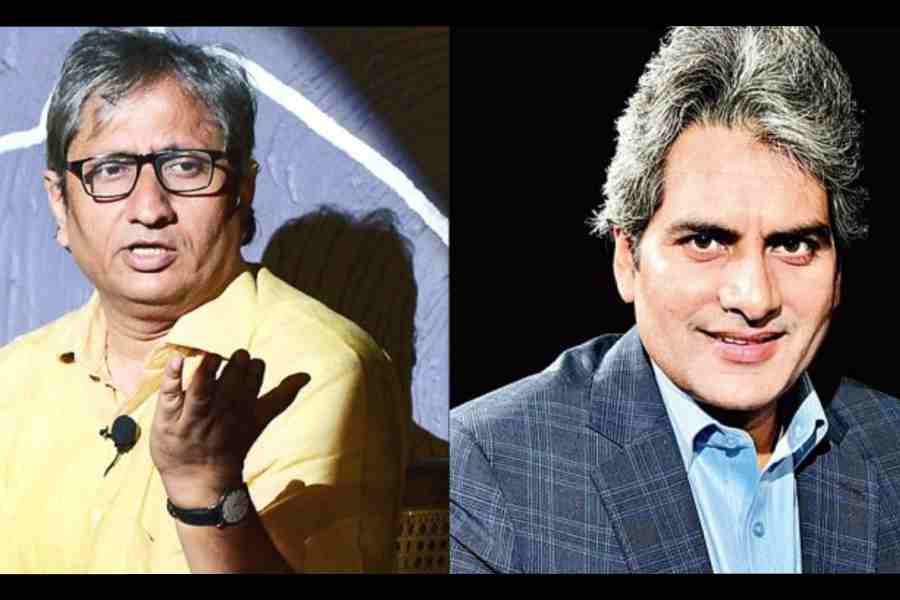Over the past week, television news has been agog with news about its own fraternity. Three or four unrelated developments pointed to the provocation TV can generate in a heavily political and polarised climate.
There was much excitement over the newly-formed Opposition coalition, INDIA, putting out a list of TV news anchors it would be boycotting in the build-up to state and national elections. It smacked of an amateurish strategy and provoked questions immediately: what about how these regional parties dealt with media freedom in their own states? Why name anchors and not the media-owners whose sanction they evidently have to bait the Opposition? Meanwhile, one of the reasons given for the choice of anchors named was that these persons had joined Bharatiya Janata Party WhatsApp groups.
In the righteous commentary that followed, people forgot that our prime minister has made a permanent refusal to engage with the media — except for a chosen few — the cornerstone of his government’s media strategy. There were no press conferences even after the self-proclaimed grand success of G20! Walking out of TV shows whose anchors’ questions he did not like is something that dates back to Narendra Modi’s days as Gujarat chief minister.
Meanwhile, also last week, the Karnataka Police decided to book the Aaj Tak anchor, Sudhir Chaudhary, for “conspiring to disrupt communal harmony”. A police complaint was filed by an official of the Karnataka Minorities Development Corporation following a show in which the anchor allegedly claimed commercial vehicle subsidies were being provided only for minorities in Karnataka and not for Hindus. He was booked under various sections of the Indian Penal Code for promoting enmity between groups by the Seshadripuram police in Bengaluru. Chaudhary is one of the anchors whose shows INDIA says its panellists will not appear on.
Some of the news-making last week was done by NDTV’s Mumbai bureau chief Sohit Mishra who said he had resigned because his channel had asked him to ‘create a ruckus’ at a Rahul Gandhi press conference on Adani. Even as the channel head denied it, Mishra put out a video announcing that he was starting his own YouTube channel.
Then came the Supreme Court’s decision the same week to crack down on media trials. It wanted the police to be properly trained for media briefings so that these would not provide fodder for sensationalism. What it calls “biased reporting (that) gives rise to public suspicion the person has committed an offence” is a hugely understated reference to the kangaroo courts TV studios transform themselves into when a sensational murder or suicide takes place. The court said that whereas “at every stage, every accused is entitled to presumption of innocence… Media reportage that implicates an accused is unfair.” Again, ‘unfair’ is putting it mildly. Sushant Singh Rajput’s death, circa 2020, is an example of the horrific TV reporting that ensued.
The universe of television news in this country today reflects all of the following traits: amoral channel owners who have become accustomed to putting viability before media ethics; TV professionals honing their craft to provoke or titillate rather than inform audiences; polarised news consumers who patronise such shows; and a political class which rejects the need for media accountability even as it invests in communal and partisan politics as elections draw near.
Newslaundry’s constant humorous rip-offs of TV news document unspeakable hate-mongering on some channels, much of it targeting Muslims. What sort of a regulatory environment permits this?
Channel-owners are willing to let their anchors exploit hate as a business model. If an anchor such as Sudhir Chaudhury, accused of hate-mongering, is able to move to Aaj Tak, it says something about how compromised the TV news industry is. Presumably, he is in demand for the ratings he brings. The Times Group, meanwhile, is happy with aggressive shows of loyalty to the party in power by the news anchors on its channels.
At the core of the distortions in TV news is the issue of viability. As audiences turn away because of growing video consumption on social and digital media, as news avoidance sets in (as documented in the Reuters Institute Digital News Report 2023), the desperation grows. Advertisement-dependent news channels will promote hysterical TV if it gets the eyeballs. Doing reporting costs money, doing debates costs far less. There are far too many news channels today for advertising to sustain them all. Meanwhile, content creators on YouTube are taking away eyeballs.
TV journalism used to be the face of journalism for the Indian people. But it is at least a couple of decades since channels stopped sending reporters out to gather news except at election time. Meanwhile the rise of digital video has seen YouTube channels competing for the attention of news viewers. When a Barkha Dutt, or Ravish Kumar or Karan Thapar, or Ashutosh or Sohit Mishra leaves a mainstream news channel, they are able to create their own news brand for viewers to watch on their phones. Even if the revenue sharing on YouTube is skewed heavily towards the platform, it still yields a revenue model.
Alongside the unfolding developments described above, a film on Ravish Kumar, who built NDTV India, that had not been released for public viewing suddenly found its way to YouTube. Titled While We Watched, it documents the commercial decline of the channel after its reporting was critical of the present BJP regime.
The Ravish Kumar story unfolds with Arnab Goswami of Republic TV intermittently shrieking about nationalism in the background. It focuses on the hate-mongering against Kumar. It has just been featured on a CNN news show. But you find his journalism had turned declamatory as well, reflecting both shrinking reporting resources and his own despondency. Having resigned from NDTV after the Adani takeover, his YouTube channel, Ravish Kumar Official, now allows him to declaim again, ranting against the sins of the current dispensation. You can choose to watch him or Sudhir Chaudhary or one of the others who are in favour with the ruling dispensation. Polarised, declamatory newscasts are unlikely to make way for TV reporting any time soon.
Sevanti Ninan is a media commentator and was the founder-editor of TheHoot.org










